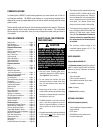
NOTE: DIAGRAMS & ILLUSTRATIONS ARE NOT TO SCALE.
Cold Climate Installations
Climates where temperatures will fall below
32° F (0° C).
The heating performance of the appliance will
vary depending upon the level of insulation,
house design, how the appliance is operated,
etc.
If this fireplace is being installed in a cold
climate, it is especially important to seal all
cracks around the fireplace and wherever cold
air could enter the room with noncombustible
material. Also, the outside air inlet duct should
be wrapped with noncombustible insulation
to minimize the formation of condensation.
Do not place insulation materials directly
against the chimney sections. We recom-
mend that you use the insulated wall radiation
shield since it will maintain the home’s thermal
barrier. AC chimney is NOT recommended in
cold climates.
8
Mantel
A wood mantel, if installed, must be at least
48" (1.2 m) above the base of the fireplace (see
Figure 7a
). There is no restriction regarding
the length or the width of the mantel.
Hearth Extension Requirements
(refer to Figures 7a and 7b)
A non-combustible hearth extension must
be built in front of the fireplace and extend
out on both sides. Hearth extensions must
be constructed according to the following
guidelines:
1. A layer of sheet metal 0.018" (0.45mm) thick
or 3/8" (9mm) thick insulating board or any
other material (tiles, marble, granite) with
equivalent heat resistance may be used.
Check with the local building authorities
before installing to determine what other
materials are acceptable in your area.
2. The hearth extension should be secured to
the floor. The gap between the fireplace and
the hearth extension must be sealed. The sup-
plied safety metal strip must be positioned
as follows: One half under the front of the
fireplace and the other half must extend on
the floor over which the hearth extension will
be built (see Figure 7a).
* The safety metal strip must cover the entire
width of the fireplace.
3. On a raised base or raised hearth, a “Z” shape
piece of metal must be fabricated to join the
bottom of the fireplace to the floor.
Outside Air Assembly
The outside air assembly is mandatory for
the fireplace.
During operation, the fireplace requires air for
combustion and draws air out of the house. It
may starve other fuel burning appliances such
as gas or oil furnaces. As well, exhaust blowers
and blower driven appliances may compete for
air, causing a negative pressure in the home,
resulting in smoke entering the home from
the fireplace. This situation is aggravated in
modern airtight houses.
To overcome this potential problem, the
installation of an outside air assembly is
required to provide outside combustion air to
the fireplace.
Fireplace Facing
The fireplace should be framed using 2" x 3"
(50mm x 75mm) or heavier lumber.
Figure 10
on Page 10 shows the general
framing layout.
Combustible materials must be installed flush
with the fireplace facing. They may not project
out in front of the fireplace. Non-combustible
materials such as brick, stone or ceramic tile,
may project in front of and/or on the fireplace
facing.
Figure 6
Figure 7b
DRYWALL PANEL OR EQUIVALENT
SPACER
2" x 3" MIN.
FIREPLACE
18"
48"
Min.
52"
1"
8"
WARNING: THE HEARTH EX-
TENSION IS TO BE INSTALLED
ONLY AS ILLUSTRATED.
The crack between
the fireplace and the
hearth extension must
be sealed with a non-
combustible material
such as sand-cement
grout.
Safety Metal Strip
Hearth Extension
Non-Combustible
Finish Material
Floor
Figure 7a - Hearth Extension Requirements


















